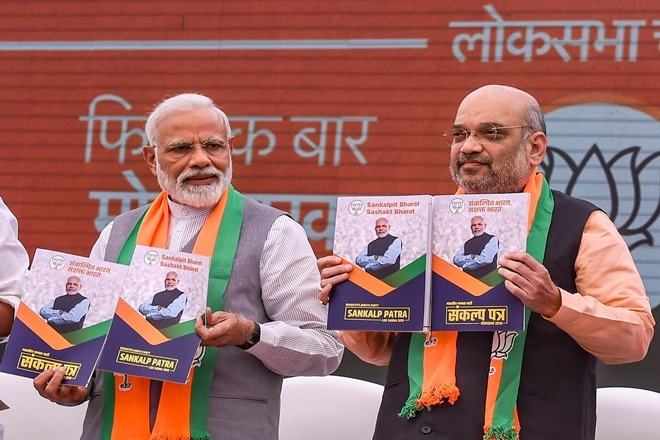In keeping with its tough image, it is not surprising that the BJP’s manifesto reiterates the government’s zero-tolerance policy towards terrorism and national security and also reiterates its position on Article 35A and 370; the party’s position on Ram Mandir and Sabarimala is also reiterated to underline its commitment to Hindutva. If neither demonetization – except in a general statement in party president Amit Shah’s cover note – nor gauraksha figure in the manifesto, it suggests the BJP realizes its mistake and wants to move on. Not surprisingly, given the government’s great success in delivering on physical targets, many of the promises made in the manifesto look quite credible. So, when the manifesto says the government will build 60,000 km of national highways, it seems credible since the 39,350 km built in the last five years were a 70% step up over UPA-2’s 24,690 km. Similarly, after being able to build nine crore toilets under Swachh Bharat Mission, it sounds credible if the party promises to take this to the next level and focus on solid waste management in every village. Apart from delivering LPG cylinders to six crore families, other achievements include 34 crore Jan Dhan bank accounts, 1.2 crore pucca houses, five crore farmers covered under crop insurance in FY18, five crore persons covered under subsidized life insurance and 13.5 crore under personal accident insurance schemes in FY19.
While the manifesto lists many major reforms – JAM, IBC, GST – which have either done well or are work-in-progress, what is missing, however, is a credible market-reforms plan to ensure that many of the growth objectives, including on GDP, are achieved. In the agriculture sector, for instance, the BJP’s biggest failure was its inability to create a pan-Indian agriculture market and, instead, it opted for solutions like MSP that further distorted the market; in this manifesto too, sadly, the MSP-hike is touted as a big achievement. And while the Rs 6,000 per family per year payment under PM Kisan is a good idea, it was introduced precisely because other agriculture schemes – like MSP – were not helping; and, apart from trying to match the Congress’s populist NYAY, it is not clear why the manifesto says PM Kisan benefits are to be provided to all farmers instead of just small ones. Interest-free loans of up to Rs 1 lakh, similarly, are to be provided to all farmers; as so many ICRIER reports have shown, given the level of leakages in subsidized farm loans, this is needless populism that could have been avoided had there been genuine farm reform. Ideally, as such subsidies – and those on fertilizer or water or electricity – should have been subsumed into a PM Kisan-type cash transfer scheme.
The promise of a Rs 50-lakh collateral-free loan to small industry also seems a reaction to the Congress manifesto, as is the promise to get government and PSUs to procure from SMEs where women staffers are at least 50% of the total. Given the rise in NPAs, and the fairly large levels in the case of the priority sector, the collateral-free loans are clearly a negative. Once again, the solution would have been to bring in more robust industrial reforms; the fact that the party takes pride in raising the minimum wage by 42% – at a time when India is losing competitiveness – instead of planning labour and other reforms is worrying, though it is possible to argue that an election manifesto is not the place to publicize this. It is heartening, though, to hear the BJP talk of the need to lower interest rates, and how its cleaning up of bank NPAs via the insolvency code is playing a role in this; high real interest rates have played a big role in India’s lack of competitiveness. As this newspaper has detailed, several critical industries have been hit by the government’s inability to carry out adequate reform.
Given the controversy over whether or not an adequate number of jobs have been created, it is not surprising the BJP has steered clear of quantifying how many jobs it will create, more so since employment elasticity has been declining for decades. But if GDP growth is to be sustained, and then raised, India needs a lot more market-based economic reforms that have taken place in the last five years; sadly, should the BJP come back to power, not enough have been promised for the next five either.

